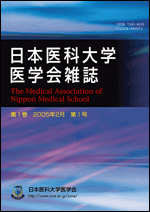13 巻, 4 号
選択された号の論文の30件中1~30を表示しています
- |<
- <
- 1
- >
- >|
橘桜だより
-
2017 年 13 巻 4 号 p. 169
発行日: 2017/10/15
公開日: 2017/11/20
PDF形式でダウンロード (261K)
グラビア
-
2017 年 13 巻 4 号 p. 170-171
発行日: 2017/10/15
公開日: 2017/11/20
PDF形式でダウンロード (269K)
綜説
-
2017 年 13 巻 4 号 p. 172-179
発行日: 2017/10/15
公開日: 2017/11/20
PDF形式でダウンロード (519K) -
2017 年 13 巻 4 号 p. 180-189
発行日: 2017/10/15
公開日: 2017/11/20
PDF形式でダウンロード (1457K)
特集〔動脈硬化症基礎から臨床へ〕第27回公開「シンポジウム」
-
2017 年 13 巻 4 号 p. 190-193
発行日: 2017/10/15
公開日: 2017/11/20
PDF形式でダウンロード (617K) -
2017 年 13 巻 4 号 p. 194-198
発行日: 2017/10/15
公開日: 2017/11/20
PDF形式でダウンロード (357K) -
2017 年 13 巻 4 号 p. 199-204
発行日: 2017/10/15
公開日: 2017/11/20
PDF形式でダウンロード (705K) -
2017 年 13 巻 4 号 p. 205-209
発行日: 2017/10/15
公開日: 2017/11/20
PDF形式でダウンロード (687K) -
2017 年 13 巻 4 号 p. 210-213
発行日: 2017/10/15
公開日: 2017/11/20
PDF形式でダウンロード (561K)
看護師シリーズ
-
2017 年 13 巻 4 号 p. 214-215
発行日: 2017/10/15
公開日: 2017/11/20
PDF形式でダウンロード (185K) -
2017 年 13 巻 4 号 p. 216-219
発行日: 2017/10/15
公開日: 2017/11/20
PDF形式でダウンロード (249K)
話題
-
2017 年 13 巻 4 号 p. 220-221
発行日: 2017/10/15
公開日: 2017/11/20
PDF形式でダウンロード (282K)
関連施設だより
-
2017 年 13 巻 4 号 p. 222-223
発行日: 2017/10/15
公開日: 2017/11/20
PDF形式でダウンロード (563K)
JNMSのページ
-
2017 年 13 巻 4 号 p. 224
発行日: 2017/10/15
公開日: 2017/11/20
PDF形式でダウンロード (160K)
集会記事
-
2017 年 13 巻 4 号 p. 225-226
発行日: 2017/10/15
公開日: 2017/11/20
PDF形式でダウンロード (617K)
第85回日本医科大学医学会総会抄録
-
2017 年 13 巻 4 号 p. 227
発行日: 2017/10/15
公開日: 2017/11/20
PDF形式でダウンロード (116K) -
2017 年 13 巻 4 号 p. 228
発行日: 2017/10/15
公開日: 2017/11/20
PDF形式でダウンロード (125K) -
2017 年 13 巻 4 号 p. 229
発行日: 2017/10/15
公開日: 2017/11/20
PDF形式でダウンロード (171K) -
2017 年 13 巻 4 号 p. 230
発行日: 2017/10/15
公開日: 2017/11/20
PDF形式でダウンロード (153K) -
2017 年 13 巻 4 号 p. 231
発行日: 2017/10/15
公開日: 2017/11/20
PDF形式でダウンロード (125K) -
2017 年 13 巻 4 号 p. 232
発行日: 2017/10/15
公開日: 2017/11/20
PDF形式でダウンロード (149K) -
2017 年 13 巻 4 号 p. 233
発行日: 2017/10/15
公開日: 2017/11/20
PDF形式でダウンロード (115K) -
2017 年 13 巻 4 号 p. 234
発行日: 2017/10/15
公開日: 2017/11/20
PDF形式でダウンロード (128K) -
2017 年 13 巻 4 号 p. 235
発行日: 2017/10/15
公開日: 2017/11/20
PDF形式でダウンロード (123K) -
2017 年 13 巻 4 号 p. 236
発行日: 2017/10/15
公開日: 2017/11/20
PDF形式でダウンロード (88K) -
2017 年 13 巻 4 号 p. 237-238
発行日: 2017/10/15
公開日: 2017/11/20
PDF形式でダウンロード (176K) -
2017 年 13 巻 4 号 p. 239
発行日: 2017/10/15
公開日: 2017/11/20
PDF形式でダウンロード (117K) -
2017 年 13 巻 4 号 p. 240
発行日: 2017/10/15
公開日: 2017/11/20
PDF形式でダウンロード (144K) -
2017 年 13 巻 4 号 p. 241-242
発行日: 2017/10/15
公開日: 2017/11/20
PDF形式でダウンロード (206K) -
2017 年 13 巻 4 号 p. 243
発行日: 2017/10/15
公開日: 2017/11/20
PDF形式でダウンロード (869K)
- |<
- <
- 1
- >
- >|
